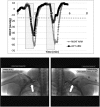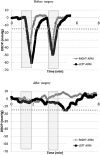Microvascular Response to the Roos Test Has Excellent Feasibility and Good Reliability in Patients With Suspected Thoracic Outlet Syndrome
- PMID: 30846945
- PMCID: PMC6393400
- DOI: 10.3389/fphys.2019.00136
Microvascular Response to the Roos Test Has Excellent Feasibility and Good Reliability in Patients With Suspected Thoracic Outlet Syndrome
Abstract
Background: Exercise oximetry allows operator-independent recordings of microvascular blood flow impairments during exercise and can be used during upper arm provocative maneuvers. Objective: To study the test-retest reliability of upper-limb oximetry during the Roos test in patients with suspected thoracic outlet syndrome (TOS). Materials and Methods: Forty-two patients (28 men, 14 women; mean age: 40.8 years) were examined via transcutaneous oxygen pressure (TcpO2) recordings during two consecutive Roos tests in the standing position. The minimal decrease from rest of oxygen pressure (DROPmin) value was recorded after each maneuver was performed on both arms. The area under the receiver operating characteristic (ROC) curve defined the DROPmin diagnostic performance in the presence of symptoms during the tests. The Mann-Whitney U-test was used to compare the DROPmin in the symptomatic vs. asymptomatic arms. The test-retest reliability was analyzed with Bland-Altman representations. The results are presented as means ± standard deviations (SD) or medians [25-75 percentiles]. Results: The symptoms by history were different from the symptoms expressed during the Roos maneuvers in one-third of the patients. The DROPmin measurements were -19 [-36; -7] mmHg and -8 [-16; -5] mmHg in the symptomatic (n = 108) and asymptomatic (n = 60) arms, respectively. When TOS observed on ultrasound imaging was the endpoint, the area under the ROC curve (AUC) was 0.725 ± 0.058, with an optimal cutoff point of -15 mmHg. This value provided 67% sensitivity and 78% specificity for the presence TOS via ultrasound. When symptoms occurring during the test represented the endpoint, the AUC was 0.698 ± 0.04, with a cutoff point of -10 mmHg. This provided 62% sensitivity and 66% specificity for the presence of pain in the ipsilateral arm during the test. The test-retest reliability of DROPmin proved to be good but not perfect, partly because of unreliability of the provocation maneuvers. Conclusion: To the best of our knowledge, this study is the first to investigate microvascular responses during the Roos maneuver in patients with suspected TOS. The presence of symptoms was significantly associated with ischemia. TcpO2 facilitated the recording of both macrovascular and microvascular responses to the Roos test. The Roos maneuver should probably be performed at least twice in patients with suspected TOS.
Keywords: exercise; ischemia; microcirculation; oximetry; peripheral artery disease; provocative maneuvers.
Figures




References
-
- Abraham P. (2006). Validation of a new device for transcutaneous oxygen pressure recordings in real and simulated exercise tests. Med. Sci. Sports Exerc. 25 190–196. - PubMed
-
- Abraham P., Picquet J., Bouye P., L’Hoste P., Enon B., Vielle B., et al. (2005). Transcutaneous oxygen pressure measurements (tcpO2) at ankle during exercise in arterial claudication. Int. Angiol. 24 80–88. - PubMed
-
- Abraham P., Picquet J., Vielle B., Sigaudo-Roussel D., Paisant-Thouveny F., Enon B., et al. (2003). Transcutaneous oxygen pressure measurements on the buttocks during exercise to detect proximal arterial ischemia: comparison with arteriography. Circulation 107 1896–1900. 10.1161/01.CIR.0000060500.60646.E0 - DOI - PubMed
LinkOut - more resources
Full Text Sources

